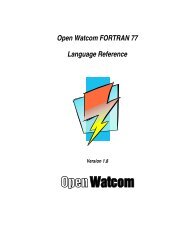Relocatable Object Module Format (OMF) Specification
Relocatable Object Module Format (OMF) Specification
Relocatable Object Module Format (OMF) Specification
You also want an ePaper? Increase the reach of your titles
YUMPU automatically turns print PDFs into web optimized ePapers that Google loves.
<strong>Relocatable</strong> <strong>Object</strong> <strong>Module</strong> <strong>Format</strong><br />
Examples<br />
The following examples of Microsoft assembler SEGMENT directives show the resulting values for the A field in<br />
the corresponding SEGDEF object record:<br />
aseg SEGMENT at 400h ; A = 0<br />
bseg SEGMENT byte public 'CODE' ; A = 1<br />
cseg SEGMENT para stack 'STACK' ; A = 3<br />
The following examples of assembler SEGMENT directives show the resulting values for the C field in the<br />
corresponding SEGDEF object record:<br />
aseg SEGMENT at 400H ; C = 0<br />
bseg SEGMENT public 'DATA' ; C = 2<br />
cseg SEGMENT stack 'STACK' ; C = 5<br />
dseg SEGMENT common 'COMMON' ; C = 6<br />
In this first example, the segment is byte aligned:<br />
0 1 2 3 4 5 6 7 8 9 A B C D E F<br />
0000 98 07 00 28 11 00 07 02 01 1E ....(.....<br />
Byte 00H contains 98H, indicating that this is a SEGDEF record.<br />
Bytes 01-02H contain 0007H, the length of the remainder of the record.<br />
Byte 03H contains 28H (00101000B), the ACBP byte. Bits 7-5 (the A field) contain 1 (001B), indicating that this<br />
segment is relocatable and byte aligned. Bits 4-2 (the C field) contain 2 (010B), which represents a public combine<br />
type. (When this object module is linked, this segment will be concatenated with all other segments with the same<br />
name.) Bit 1 (the B field) is 0, indicating that this segment is smaller than 64K. Bit 0 (the P field) is ignored and<br />
should be 0, as it is here.<br />
Bytes 04-05H contain 0011H, the size of the segment in bytes.<br />
Bytes 06-08H index the list of names defined in the module's LNAMES record. Byte 06H (the Segment Name<br />
Index field) contains 07H, so the name of this segment is the seventh name in the LNAMES record. Byte 07H (the<br />
Class Name Index field) contains 02H, so the segment's class name is the second name in the LNAMES record.<br />
Byte 08H (the Overlay Name Index field) contains 1, a reference to the first name in the LNAMES record. (This<br />
name is usually null, as MS-DOS ignores it anyway.)<br />
Byte 09H contains the Checksum field, 1EH.<br />
The second SEGDEF record declares a word-aligned segment. It differs only slightly from the first.<br />
0 1 2 3 4 5 6 7 8 9 A B C D E F<br />
0000 98 07 00 48 0F 00 05 03 01 01 .. H......<br />
Bits 7-5 (the A field) of byte 03H (the ACBP byte) contain 2 (010B), indicating that this segment is relocatable and<br />
word aligned.<br />
Bytes 04-05H contain the size of the segment, 000FH.<br />
Byte 06H (the Segment Name Index field) contains 05H, which refers to the fifth name in the previous LNAMES<br />
record.<br />
Byte 07H (the Class Name Index field) contains 03H, a reference to the third name in the LNAMES record.<br />
40 <strong>OMF</strong> <strong>Specification</strong>, Version 1.1 Tool Interface Standards (TIS)
















